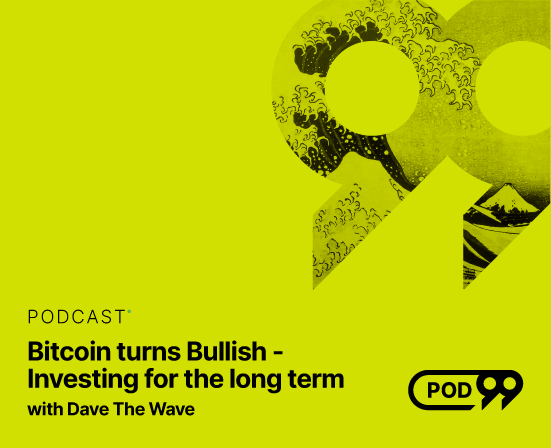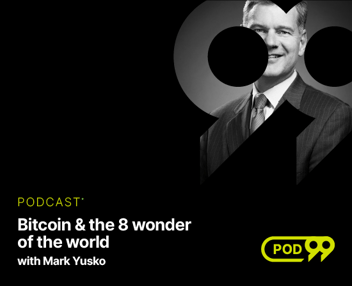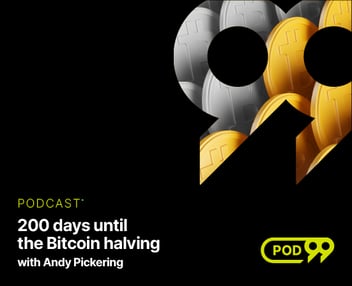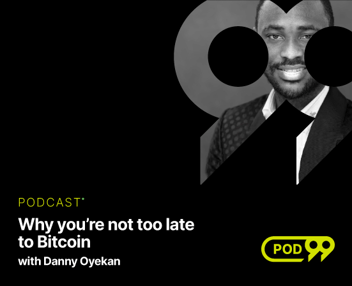On this week's episode of POD99, Dave The Wave, a pseudo-anonymous investor, trader, and technical analyst, shares his unique insight into Bitcoin's chart history and potential future. As a contrarian thinker, Dave has developed the Bitcoin Logarithmic Growth Curve chart, one of the few accurate predictive models for Bitcoin's price. With Bitcoin in the LGC's buy zone and recently turning bullish, investors are eyeing it as a hedge against global central bank instability and looming inflation threats. Join Dave and Andy as they discuss Bitcoin's next moves and the potential for a new all-time high.
To view Dave the Wave's charts watch this podcast on youtube:
Andy Pickering - Host
Hey folks, welcome to POD99, a podcast where we talk to experts from within Wealth99 and across the alternative asset space. These experts share their insights on new wealth, how to build it, and how to keep it. Today, my guest is Dave the Wave, a pseudo-anonymous investor, trader, and technical analyst. As a contrarian, Dave is quite interesting. Welcome to the show, Dave the Wave.
Dave the Wave - Guest
Hey Andy, how are you doing?
Andy Pickering - Host
I am doing good, Dave. For the benefit of people who may spend less time on Twitter than you, could you give a brief introduction to yourself? Let's hear some background.
Dave the Wave - Guest
Sure. I've been charting Bitcoin and altcoins for several years, dating back to the market around 2017. Through 2018, I continued charting during the bear market, and I've been charting it since then, looking at the previous bear market and allowing for another correction. So, I've been charting Bitcoin for a long time. Besides the technical charts, I'm also very interested in macro perspectives. I write regular newsletters on Bitcoin and altcoins, trading, and investing in this tricky market. I've been doing pretty well on Twitter, my website, and my articles page, and I enjoy participating in podcasts from time to time.
Andy Pickering - Host
Yes, indeed. The reason I thought it would be good to talk to you, Dave, is because I think you have a unique insight into Bitcoin, its chart history, and its potential chart future. This is based on your famous logarithmic growth curve chart. I should point out to listeners that if you're listening to this podcast on Apple Podcasts or Spotify, Dave and I are recording this on Zoom with video. You won't see our faces; instead, you will see Dave's charts. Sometimes it's just easier to see a visual representation when talking about charts. This will be published on the Wealth99 YouTube channel, where you can see the visuals.
With that said, Dave, we have your logarithmic growth curve (LGC) on screen at the moment. Do you want to give a quick summary and background? You don't need to be super technical, but give us the thesis for the LGC.
Dave the Wave - Guest
Sure. LGC stands for logarithmic growth curve. It's something you'll find in nature, where something involves explosive exponential growth at the beginning and then tapers off and plateaus at the end. I'm pretty convinced that the price action of Bitcoin over the years on the long-term chart is tracking a log growth curve. So you get these explosive price movements and equally explosive corrections. In the aggregate, you get this arc involving diminishing returns but still good returns. I think you're still going to see good returns in Bitcoin, but not as large as what we had 4-5-6-7 years ago and in previous cycles.
The idea with the LGC is that it's a wide channel that can accommodate the price action. I highly recommend listeners look at the chart on the YouTube channel because you really need a visual of this. It's almost like geometry. The channel is not too wide to be of little use; it's narrow enough to help the investor and trader on a longer-term timeframe.
Andy Pickering - Host
I think that's really well said, Dave. Just make sure you're speaking nice and close to the mic, so we can hear you properly. I like the way you talk in terms of being halfway between an investor mindset and a trader mindset. Most people listening to this and looking at Bitcoin as an alternative asset will have a long-term timeframe in mind. You can't expect immense returns overnight, but as your chart shows, despite the extreme volatility to the upside and downside, on any longer-term time horizon, Bitcoin is still doing very well indeed. Perhaps, Dave, do you want to zoom in on the chart a little bit and talk about where we are at the moment?
Dave the Wave - Guest
Sure. What I've got here is pretty zoomed out. If I zoom in a little, we've seen a long correction come down. I've put a lower boundary on the LGC, the lower boundary of the channel, and that's something I've termed the buy zone. Since 2018, when investors have bought in the buy zone, they've done pretty well. The buy zone suggests a buy for the long-term investor and also stops you from buying once the price gets above it into the middle or top of the channel. It's a good signal to show when prices are getting toppy, and you want to be cautious about buying.
In 2018, the price was under this channel for quite a while and then took off to the upside. We saw a mini bubble or mini parabolic rise in 2019, and it came off. I think that was the COVID collapse. The price came back to the buy zone and stayed there for a while, then it took off again in the end of 2020 and 2021. We hit a double top, and that was when I suggested being cautious. My charts are primarily about investing, not trading. Traders can trade the volatility, and some do very well, but for investors, unfortunately, people tend to buy the tops and get caught out. That's fine for the first time, but after that, you want to be a bit savvier with the price. After the double top, we saw an extended correction. The big question is whether we're at a bottom now. We're certainly back in the buy zone that's been on the chart for a few years. The price has been on the lower boundary for nearly a year, since June of last year, and we're now in March.
We've been in the buy zone for almost a year, and it's holding up, with a horizontal line threatening to break out. When I talk about the buy zone, I'm referring to the slightly shaded area at the bottom of the channel.
Andy Pickering - Host
As you rightly point out, Dave, Bitcoin has been in the buy zone for almost a year now. I remember back in 2021 when Bitcoin was hitting all-time highs, and you were publishing your charts then. I thought the buy zone looked a long way down, and we would never go back there. Inevitably, Bitcoin did crash, and we are back down here. This is the longest time that Bitcoin has spent at the bottom of the channel or the bottom of the LGC in the buy zone. These are interesting times, but this is the time, not financial advice, for investors with a long-term time horizon to consider accumulation, Dave.
Dave the Wave - Guest
Yes, I think so. I mean, there are no certainties, as most of us are completely aware that there are no guarantees with any investment or trading. However, as far as this model goes, and I'd call it a macroeconomic model for the price of Bitcoin, I think you've got a pretty good strategy going on here. If you buy within this buy zone, I've always recommended purchasing a few tranches over a reasonable period of time. So once the price enters the buy zone, you could have bought a tranche, held off, and then, a month or two later, bought another tranche. And, indeed, we saw the significant dip, with the lowest price occurring in November. You would have gone underwater by a few percent, but this is Bitcoin, right? Volatility in Bitcoin is normal.
So you have to expect that you're never going to buy the perfect bottom. By purchasing in a few tranches, you can spread that risk. At the same time, you're buying within the buy zone and exposing yourself to a reasonable position without being overexposed. Practicing good risk management, and then buying a third tranche maybe on the way out, as we seem to be seeing here. There's a downward diagonal line there. A cautious investor, or someone buying the third tranche, could have said, "Well, I'll wait for this line to break." Alternatively, they could still decide to wait for the horizontal break and buy the last tranche or the first tranche, depending on how cautious they are.
Considering the extended correction that has gone on for a year, including a double top and a year-long correction, it's a pretty good bet that Bitcoin is going to take off again to the upside. We all know what it's capable of. Right, we've seen it take off, and while we might think the recent price increase is significant, in percentage terms, it's not. A massive move would be something like what happened in 2019, which would take the price right out of the buy zone and up into the middle of the channel. And I think there's a fair chance that could happen.
Andy Pickering - Host
Yes, it's interesting, Dave, that the current macro backdrop reminds us of the circumstances that led to Bitcoin's creation. Born out of the 2008 financial crisis, the Bitcoin white paper was published around 2009. Now, in 2023, we find ourselves in an increasingly unstable financial environment across the globe, witnessing early signs of potential bank runs and the contagion they can cause.
You made an insightful observation about the Federal Reserve and the Treasury being caught between a rock and a hard place as they respond to inflation. As they continue to raise interest rates, it puts immense pressure on the financial system. Some banks were caught off guard when they bought treasuries and bonds, believing that the Fed would not raise rates, only to find themselves trapped later.
In a liquidity squeeze, if there's even a hint of trouble and depositors want to access their funds, the digital world we live in allows them to do so instantly, causing liquidity to run out quickly. This situation highlights the original use case and thesis for Bitcoin as a potential solution – a decentralized currency not controlled or debased by a centralized authority. It seems that more and more people are becoming aware of Bitcoin's value proposition in this context.
Dave the Wave - Guest
Yes, I think so. The key word you mentioned is "instability." Previously, people debated about inflation, hyperinflation, and deflation. While it's always a good debate to have, the instability of the currency is the real issue. The monetary shenanigans contribute to inflation expectations, and then you have bank runs and problems that are deflationary, indicating the instability of the currency, such as the USD. This instability is reflected in the Bitcoin price.
Andy Pickering - Host
Returning to the chart. The recent pop earlier this week was a result of the threat of the Silicon Valley Bank potentially going under. Since then, banking stocks have tanked, but Bitcoin has performed very well.
Dave the Wave - Guest
Yes, indeed. Gold is pushing its all-time highs. On a multi-year or multi-decade scale, it has a 10% appreciation, but what that really means is a 10% compounded depreciation of the USD against gold. Gold serves as the yardstick for all currencies, and Bitcoin is considered digital gold due to its scarcity. Obviously, Bitcoin outperforms gold, but that's another story about a nascent currency in the process of being capitalized. In the meantime, there will be huge moves in Bitcoin to the upside, accompanied by volatility as people worry about both deflation and inflation.
I wrote about this volatility in an article where I discussed the speculative LTC range or the macro channel, which is defined by both inflationary and deflationary expectations. This LTC channel absorbs the macro fears about instability. When the price was at the top, I suggested that the top part of this channel represents inflation expectations, while the bottom part represents deflationary expectations.
There is a kind of dichotomy or schizophrenic movement in the market, as it alternates between inflation and deflation, which creates a lot of instability. However, that instability is captured by the LTC model. A few years ago, many models were more optimistic, but this one was always more realistic and aimed to accommodate what we're seeing now in terms of deflationary and inflationary expectations.
Andy Pickering - Host
Yes, and that's why I referred to you as a contrarian at the beginning of the show, Dave. When we talk about other models, the famous one that some people probably know is Plan B's Stock-to-Flow model, which was, as you mentioned, optimistic. Subsequently, that model has failed, and your model, Dave, is the only one that's been published and received attention; it's the last one standing. As a contrarian, when Bitcoin was at its all-time highs, you were saying that it was time to be cautious, and you were right. Now, when Bitcoin is at the bottom of the channel and in the buy zone, this might be the time to take a closer look.
Dave the Wave - Guest
I think the term "deflation" has been almost a dirty word to those focused on hyperinflation in the past. However, with deflation, it's true that asset prices come off, which is why people worry about it. They think that if there's deflation, then Bitcoin as an asset will see its price drop. But Bitcoin is not just an asset; it also has a dual function as it can absorb inflationary expectations. Additionally, when deflation is on the table, it also acts as a currency. If anything, that's what the LTC is about. It represents a nascent currency in the process of capitalization, meaning it's being capitalized. At some point, it may equal or surpass the market cap of gold. The point is, Bitcoin will likely mimic what gold has been doing over the years.
Andy Pickering - Host
Indeed, Dave, it will happen much faster. While gold has had hundreds, if not thousands, of years to become a capitalized currency, and gold's story is essentially the story of how humans understand currency, Bitcoin is a nascent currency in the process of capitalization. Having only existed for around 15 years, Bitcoin already has an impressive market cap and is on its way to catching up with gold eventually. But as you rightly point out, for a new form of currency to be invented, there's going to be volatility along the way as speculators go in and out and confidence fluctuates.
With each cycle repeating, the overall market cap increases by an order of magnitude. So with that in mind, Dave, I think it'd be fun, just for entertainment purposes, to talk about the upper limits of the channel or where Bitcoin could potentially hit if we do eventually start to approach a market cap similar to gold. Let's maybe zoom in on the chart a bit and approach that however you'd like.
Dave the Wave - Guest
Yeah, I mean, this speculation and volatility exist within a spectrum of speculation. You could say that Bitcoin is bubble-like, though I don't think it's a bubble. Instead, it goes through a series of manias or speculative episodes that resemble bubbles, and each bubble pops. This leads to a cycle in which the bubble pops, corrects itself, and then another one arises. This speculation serves as the means of capitalization. So, in the aggregate, as you were saying, it's always appreciating towards a certain point. Now, your question was about possible price predictions, right?
Andy Pickering - Host
Well, first, let's zoom in, Dave. So, if we understand that we are currently in the buy zone at the bottom of the channel, obviously, no one can predict the future. However, Bitcoin is in a bear market at the moment, and presumably, the bull market will return. That means, at some point, Bitcoin will make its way towards the top of the channel again. Since the numbers are quite small and might be hard for people to read on your chart, could you give us an idea of when you think it could hit the top of the channel and what kind of prices those might be?
Dave the Wave - Guest
Regarding speculation, I believe the old four-year cycle, which we're accustomed to, has evolved because now we see the price just steadily chugging along the channel. After experiencing a major correction, the price continues to progress within the channel until we witness a significant spike following the halving event.
I believe that past price cycles have taught us that they are becoming more irregular, as seen through 2019. We can observe the price steadily progressing within the channel, experiencing corrections, and then seeing sudden jumps in value, followed by more corrections. I think Bitcoin is teaching us that it's unpredictable and volatile.
We should emphasize the volatility and instability of the prices. While it wouldn't surprise me to see the price jump out of this buy zone, I also think it's possible for the price to stay in the buy zone for an extended period. It's important to consider various scenarios when trying to predict Bitcoin's movements.
One such scenario I have in mind is that we might see a double top followed by a correction, and then the price may gradually push towards the all-time highs again within this year. While it seems awfully high, if we look at the trajectory on the LTC, it's not entirely out of the realm of possibility.
In the middle of the channel, we see a pattern similar to 2019, where it reached close to its peak. However, we often get caught up in the numbers like 30,000 or 20,000, but in logarithmic terms, it wasn't far off. I speculate that we might see the price pushing all-time highs, followed by another correction back to the buy zone, with prices still remaining relatively high, possibly in the 30k range. Afterward, we could see a significant run, potentially forming a reverse head and shoulders pattern, leading up to around 200k.
I'm sketching out a scenario here, but these macro trends make sense to me, even though the price appears to be becoming less volatile and more stable in the macro context. This scenario would make this year quite bullish, followed by a correction and a good run going into 2024-2025.
For investors, the specifics may be less important than identifying the right time to buy at the bottom and sell somewhere higher up, perhaps around 180k to 200k as a realistic target. Assuming this occurs around 2023, 2024, or 2025, the returns on investment for those buying around the current levels would be quite impressive.
Andy Pickering - Host
If you were to buy now and sell around 180,000 to 200,000 US dollars per Bitcoin, potentially in 2024 or 2025, it doesn't get much more bullish than that. We don't know if that will play out. But what's interesting, Dave, is that the next Bitcoin halving is just over a year away, likely taking place around April 2024. I know you've talked about how the cycles don't necessarily play out the same way they have in the past. Nonetheless, the amount of new Bitcoins being produced each day will reduce by half in 2024. If there are more buyers than sellers, and there's less Bitcoin being produced, that certainly doesn't hurt Bitcoin's chances at slow and steady price appreciation.
Dave the Wave - Guest
Yeah, we'll see how this scenario unfolds, and I'm not going to pin all my hopes on it. I invest in Bitcoin and also trade altcoins as a hedge against that. This scenario ties in nicely with the halving. I think the halving will have less and less impact as Bitcoin becomes a more mature market. The next halving may have some influence, but the following one in 2028 may not, as the market will be much more mature by then.
This idea or scenario I've sketched here aligns well with the halving narrative. In 2019, there was a push up, a correction, and then the big move following the halving. Here, it's pretty well timed with the scenario where the halving precedes the big move up. There are other reasons why I'm favoring this because the correction in all the cycles is increasing as the price plateaus. A couple of cycles ago, we had a 23% correction, then a 38% correction, and now we see a 50% correction. I think we're going to see a 61% correction next.
This also ties in with measuring from the base after a mini bubble, and I'm getting that 61% that I'm looking for on this big move. For me, that's another macro factor that makes me favor something like this. As we go forward, Bitcoin is still going to be volatile, but nothing like what we've seen in the past. That's another consideration.
Andy Pickering - Host
Alright, well, thank you, Dave. It's been a privilege to get some live charting from you, focusing on Bitcoin and your world-famous Logarithmic Growth Curve. It's great to have you on the show, talking through the chart. I suppose, just to finish off, it would be good to hear your thoughts on how to stay sane as an investor, Dave, in these unpredictable and volatile times – because it seems we do live in unpredictable and volatile times, you know?
Dave the Wave - Guest
Well, you know, when there's instability, there's opportunity, right? So, I love this volatility because you can use it to your advantage, and the volatility and instability should be central to the trader or investor. Furthermore, trading is all about hedging. So, I have a core position in Bitcoin, and I have bought Bitcoin and just held onto that. To hedge, I have traded altcoins against USD, and I am not interested in trading altcoins to accumulate Bitcoin. I've got a core position in Bitcoin as an investor, but I want to hedge my crypto because the world is an uncertain place and anything could happen. So, for me, trading is hedging, and then I can skim profits, put them into real assets, and not have the emotional or anxiety about the market. So, you know, if you make profits along the way, the market can go to hell in a handbasket, and you'll still have done well.
Andy Pickering - Host
That's exactly right. Very well said Dave. And for anyone who is interested in Dave's thoughts on the market on and bitcoin trading and investing and altcoin trading and investing. I think, you know, you have a couple of subscription offerings available through the website, Dave, what's the website?
Dave the Wave - Guest
Sure, so for those who want to read my articles, like the one we briefly looked at on Bitcoin deflation, I write a newsletter that aims to address people's concerns about deflation expectations. It's called "Days Newsletter" and can be found on substack.com. Additionally, I can be found on Twitter at "DaveTheWave" without the letter "E". I encourage readers to think about macro and stay informed, especially in a volatile market. The newsletter is published every two weeks and covers a wide range of topics.
Besides that, I've also got a trading coach at Dave the wave.com. Here, I'm looking at this as a hedging page where we look at Bitcoin charts, altcoins, and their volatility. The idea is to trade their volatility for USD to balance out your crypto so your trading account is diversified. So you're not completely exposed to one space. There's also discussion of strategy and tactics on there, plenty of updated charts, and it's taking on quite nicely.
Andy Pickering - Host
All right, there you have it. Live and direct, the man himself, Dave the Wave, probably one of the best-known and most accurate Bitcoin technical analysts. It was very interesting to see Dave go through his logarithmic growth curve for us live on the show. Fantastic. Thank you, Dave. Our mission at Wealth 99 is to make alternative assets accessible to the 99% so that everyone can access the kind of financial opportunities that were once limited to the 1%. Bitcoin is one of those alternative assets, probably the number one alternative asset, but precious metals and tokenized precious metals are all part of that equation. And of course, all are available here at Wealth 99. But that's today's show. I hope you enjoyed it. You can watch it on YouTube or listen along on our new podcast, Pod 99. Don't forget to subscribe on your preferred podcast app. Thanks for listening, folks, and bye for now.
























.svg)
.svg)
.svg)



